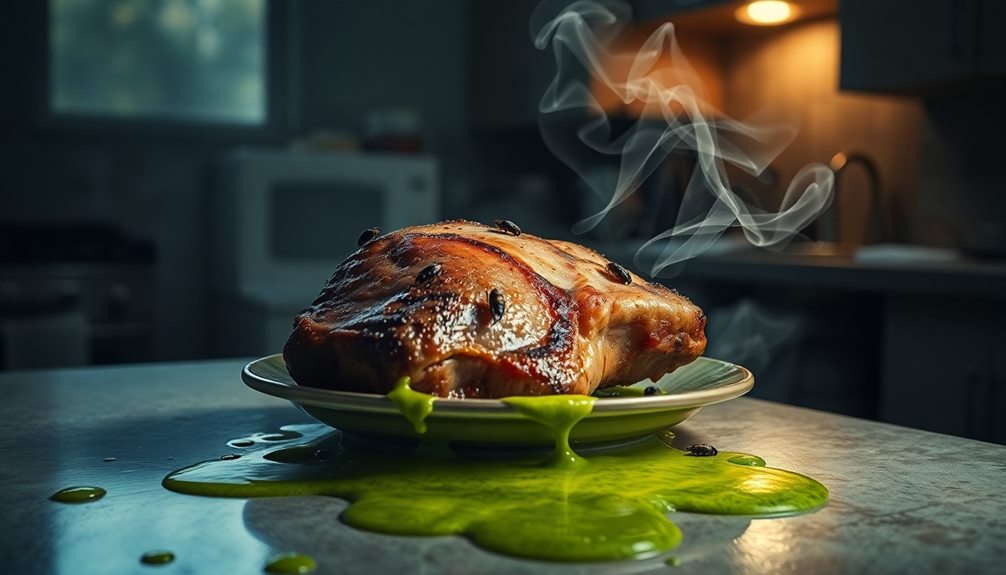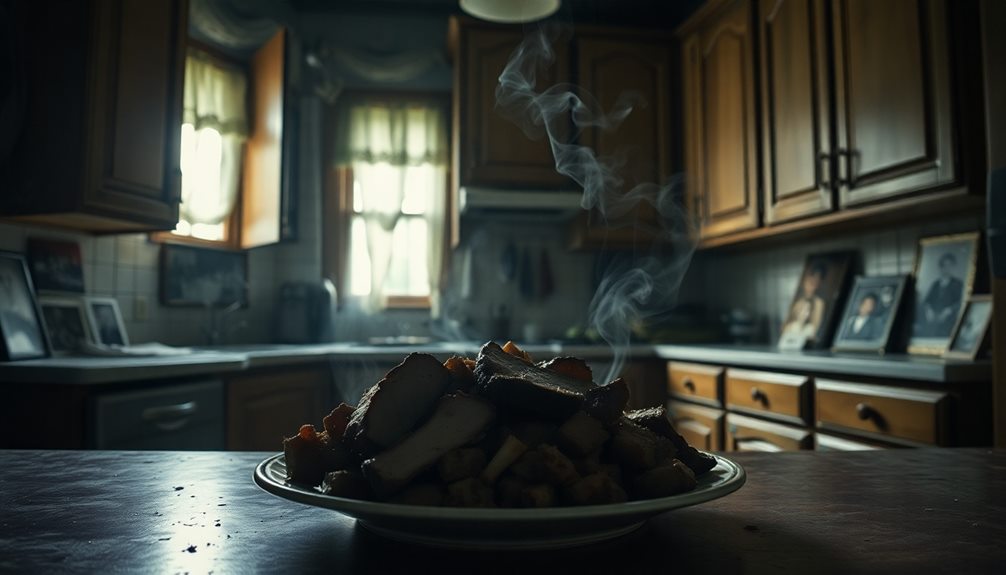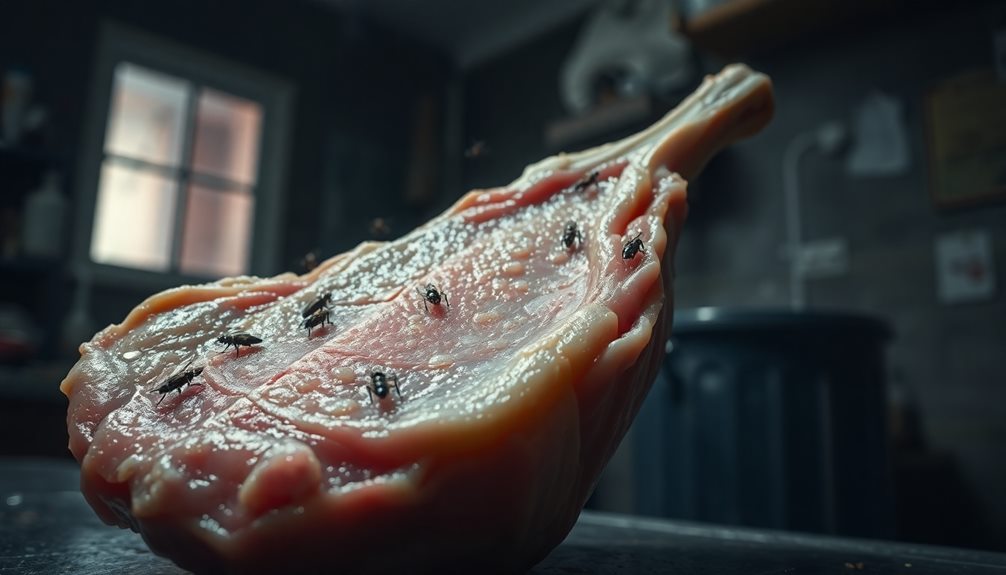Spoiled pork emits a sharp, sour smell that's unmistakable and signals that it's unsafe to eat. Often described as pungent and heavy, the odor can be overwhelming and may contain hints of ammonia. This unpleasant scent results from the breakdown of proteins and fats by bacteria, producing foul compounds. If you've left pork out at room temperature for over two hours, or notice a slimy texture or discoloration, discard it immediately. Recognizing these warning signs is crucial for avoiding foodborne illnesses, and understanding spoilage can further protect your health. You'll find additional insights on safely handling meat.
Key Takeaways
- Spoiled pork emits a sharp, sour tang and a pungent, offensive odor that can linger in the air.
- The smell may include ammonia and sulfur compounds, irritating the nose and throat.
- As pork spoils, the breakdown of proteins and fats produces unpleasant, rancid odors.
- A combination of sour and foul scents signals that the meat is unsafe for consumption.
- Recognizing these odors helps prevent foodborne illnesses linked to spoiled pork.
Introduction

When you catch a whiff of spoiled pork, it's hard to ignore the pungent odor that fills the air. Spoiled pork can pose serious health risks, making it crucial to recognize its smell and take appropriate action. Understanding the stages of spoilage is essential for food safety. Fresh pork has a mild, pleasant aroma, but as it begins to spoil, that scent changes dramatically.
Often, bacteria and other microorganisms break down the meat, leading to the production of unpleasant compounds. This process can result in various odors, signaling that the pork is no longer safe to consume. It's important to know that the smell can vary, depending on factors like storage conditions and the duration of spoilage.
Recognizing these signs can help you avoid foodborne illnesses. If you ever encounter a strong, sour smell or detect hints of ammonia, it's best to err on the side of caution and discard the meat.
Always trust your senses when handling food. Remember, it's better to waste a little than to risk your health. By being vigilant, you can enjoy pork safely and deliciously.
Description of the Smell

The smell of spoiled pork hits you with a sharp, sour tang that can linger in the air. It's an odor that's hard to ignore, often described as pungent and offensive. When you encounter it, your senses immediately react, urging you to back away.
This odor typically has a heavy, almost rotten quality, reminiscent of decaying matter. You might notice a hint of ammonia mixed in, adding to the overwhelming scent.
As you breathe in, the smell can feel sharp enough to irritate your nose and throat, making you instinctively wrinkle your face in disgust. The complexity of the odor can also include a slightly sweet note, which may seem odd but is a characteristic of decomposing proteins.
It's this combination of sour and foul that signals the meat is no longer safe to eat. If you're ever in a kitchen or market and catch a whiff of this smell, it's crucial to act quickly.
Spoiled pork poses health risks, and recognizing the smell is your first line of defense. Trust your senses; if it smells off, it's best to dispose of it immediately.
Source and Composition

Spoiled pork's unpleasant smell primarily comes from the breakdown of proteins and fats during decomposition. As the meat spoils, various microorganisms, including bacteria and fungi, begin to thrive in the warm, moist environment.
These microorganisms produce enzymes that break down the meat's cellular structure, releasing volatile compounds.
One significant source of the smell is the production of ammonia and sulfur-containing compounds. Ammonia arises from the breakdown of amino acids, while sulfur compounds contribute to a rotten egg-like odor.
Additionally, fatty acids decompose into shorter-chain fatty acids, which further intensify the rancid smell.
You might notice that the specific composition of these compounds can vary based on factors like the meat's initial quality and the conditions under which it's stored. For instance, higher temperatures accelerate spoilage, leading to a more pronounced odor.
While you might find the smell particularly offensive, it serves as a natural warning signal. It indicates that the meat is no longer safe to consume.
Awareness of these sources and compositions can help you identify spoiled pork before it poses a health risk.
Typical Scenarios or Environments

Often, spoiled pork can be found in common kitchen scenarios, such as when leftovers are stored improperly or left out at room temperature for too long. If you've cooked pork and then neglected to refrigerate it within two hours, you're likely to encounter this issue. Bacteria thrive in warm conditions, leading to spoilage that's often marked by a foul smell.
Another typical scenario occurs when you purchase pork and don't use it by the expiration date. Even if the meat appears fine, storing it for too long can result in spoilage. If you've bought pork in bulk but only use a portion, make sure to freeze the leftovers within a day or two to preserve freshness.
Additionally, cross-contamination can contribute to spoiled pork smells. If you've stored raw pork near other foods without proper sealing, the odors can migrate, making it tough to pinpoint the source of the smell.
Always keep your refrigerator organized, ensuring that raw meats are sealed and placed on lower shelves. By understanding these typical scenarios, you can better manage your pork storage and avoid unpleasant odors in your kitchen.
Emotional or Cultural Associations

When you encounter the smell of spoiled pork, it can evoke strong emotional responses tied to both personal experiences and cultural beliefs. For many, this scent might trigger memories of family gatherings or home-cooked meals gone wrong. You may recall the disappointment of a meal spoiled and the frustration that follows.
Alternatively, if you've grown up in a culture where pork is a staple, the smell could symbolize loss or waste, impacting how you perceive food and its value.
Culturally, the smell of spoiled pork can carry different meanings. In some societies, it may be seen as a sign of poor food handling or lack of culinary skills, leading to embarrassment. In others, it might represent something more serious, like health risks associated with improper food preparation.
Additionally, spoiled pork can remind you of the importance of food safety and preservation methods. This awareness often stems from cultural teachings about the significance of fresh ingredients.
Ultimately, the emotional and cultural associations tied to the smell of spoiled pork reflect deeply ingrained values and experiences, shaping how you react to it in various contexts.
Health or Safety Considerations

The smell of spoiled pork isn't just an unpleasant experience; it also raises significant health and safety concerns. When pork goes bad, harmful bacteria can proliferate, leading to foodborne illnesses. These bacteria, such as Salmonella and E. coli, produce toxins that can cause severe gastrointestinal issues, including nausea, vomiting, and diarrhea.
You need to be aware that consuming spoiled pork can quickly turn a meal into a serious health risk. If you encounter that distinct foul odor, it's crucial to trust your senses. Don't take a chance on cooking or eating pork that smells off, as the cooking process won't eliminate all toxins. Your best course of action is to discard any meat that gives off an unpleasant scent.
Additionally, proper food handling is vital in preventing spoilage. Always store your pork at the correct temperature, ideally below 40°F (4°C), and make sure to consume or freeze it before the expiration date.
Practicing good hygiene, like washing hands and surfaces, can also help minimize contamination risks. By being vigilant and cautious, you can protect yourself and your loved ones from the dangers of spoiled pork.
Final Thoughts

Spoiled pork can pose serious health risks, making it essential to prioritize safety in your kitchen. Recognizing the signs of spoilage—like an unpleasant odor, a slimy texture, or discoloration—can help you avoid consuming harmful bacteria.
Trust your senses; if something seems off, it's best to err on the side of caution and discard the meat.
Proper storage is crucial in preventing spoilage. Ensure your pork is stored in the refrigerator at temperatures below 40°F (4°C) and use it within the recommended timeframe.
If you're unsure about how long it's been in the fridge, it's safer to toss it out. When cooking pork, always ensure it reaches an internal temperature of 145°F (63°C) to kill any lurking pathogens.
Frequently Asked Questions
Can Spoiled Pork Be Cooked to Eliminate the Smell?
You can't cook spoiled pork to eliminate the smell effectively. Once meat spoils, harmful bacteria develop, making it unsafe. It's best to discard it rather than risk your health by attempting to mask the odor.
How Long Does It Take for Pork to Spoil?
Pork typically spoils within three to five days when stored in the refrigerator. If it's left out at room temperature, it can start to spoil in just a couple of hours. Always check its freshness!
What Are the Signs of Spoiled Pork Besides Smell?
You'll notice signs of spoiled pork like a slimy texture, discoloration, and the presence of mold. If it feels tacky or has an unusual appearance, it's best to discard it for safety.
Can Freezing Prevent Pork From Spoiling?
Freezing can definitely help prevent pork from spoiling by slowing down bacterial growth. However, it won't make spoiled pork safe to eat. Always check for freshness before cooking, even after freezing. Stay safe!
Is Spoiled Pork Safe to Eat if Cooked Thoroughly?
You shouldn't eat spoiled pork, even if you cook it thoroughly. Cooking won't eliminate the toxins produced by bacteria. It's best to err on the side of caution and discard any spoiled meat.










